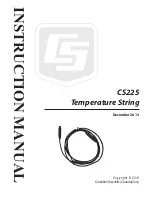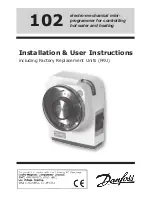
© 2019 TOSS GmbH & Co. KG -Verpackungssysteme- Alle Rechte vorbehalten! Nachdruck, auch auszugsweise, ohne unsere schriftliche Genehmigung nicht gestattet!
10
Figure 1: Calibration sequence
For each calibration, Calibration Steps 1 to 8 must be completed by the controller. Step 9 is an optional
calibration function (
5.7.4.). If an error occurs during the individual calibration steps, the PIREG-D2
stops the calibration procedure and begins a new attempt. After the fifth attempt it aborts the calibration
process with an error message (
3.7.).
After successful calibration, the PIREG-D2 returns to the Off state.
So that the heat conductor's R20 reference resistance is set correctly, calibration must be performed
when the heat conductor is at the reference temperature detected. The time required for a calibration
process is influenced by various factors. The voltage level on the heat conductor, the current passing
through it, the Ur and Ir phase shift and the P-factor of the sealing transformer-heat conductor combina-
tion determine the duration of calibration. The controller requires a maximum of 46 resp. 60 s for one
calibration process. (from V1.00/1.23/1.30/1.25)
If the calibration process is not successful, e.g. because the P-factor has been determined incorrectly, the
controller makes another four attempts before reporting an error. In this case, the maximum calibration
time can amount to 230 resp. 305 s, depending on the temperature reference time.
If the calibration mode
“New calibration”
is chosen, the controller always switches to calibration imme-
diately after a power-on or after a reset and carries out a new calibration. Calibration can also be started
in the OFF or error state with the signal “Calibration Start” or from the Calibration selection menu of the
display unit.
If the calibration mode
“Save”
is chosen, the controller switches to calibration when in an Off- or error
state or before power-on only when the “Calibration Start” signal is applied. Calibration can also be start-
ed in the Off- or error state from the Calibration selection menu on the display unit (
5.2.5.). In this type
of calibration, the calibration values are saved in a non-volatile memory and are loaded immediately after
a power-on or the “Reset" signal.
3.2.10. Single-point temperature coefficient correction:
With the single-point temperature coefficient
correction, the heat conductor’s temperature coefficient tolerances can be corrected for just one operating
point. For this operating point the heat conductor’s actual temperature is reported back to the PIREG-D2
as a set value or directly as a measurement of the thermometer exTM. The single-point temperature coef-
ficient correction is carried out outside the standard calibration and is started from the Off-state. The sin-
gle-point temperature coefficient correction has one Off- and one On-state. After the single-point tempera-
ture coefficient correction has been started, the PIREG-D2 is in the Off state. When the PIREG-D2 is in
the On-state, the heating conductor is heated to the temperature which was set as the set value in the
Off-state. After heating the temperature is only accepted when the heating conductor has definitely
reached the temperature. The actual value display or the actual value output show the PIREG-D2’s actual
value temperature, still uncorrected. The single-point temperature coefficient correction is ended upon
exiting the On-state. The correction process is controlled by the “Start”/”Heat”
selection point
in the work-
ing menu, the “Start” single or by command. When the TK correction heating period is set accordingly, the
one-point temperature coefficient correction process can also run automatically.
Deviations of up to ±20 % between the calculated actual value temperature and the actual temperature of
the heating conductor can be corrected. The single-point temperature coefficient correction can only be
performed if the normal temperature coefficient correction covering eight points (
3.2.9.) has not been
carried out during calibration. The single-point temperature coefficient correction is reset at each calibra-
tion.
The temperature coefficient correction can be saved, so that it does not have to be performed again in the
case of a new calibration process, but only when the heat conductor is changed (
5.2.5.)
Performing the single-point temperature coefficient correction:
- manual operation:
Single-point temperature coefficient correction is started from the Calibration selec-
tion menu on the display unit (
5.2.5.) of the PIREG-D2 or by command when the PIREG-D2 is in the
Off-state. The PIREG-D2 retains the temperature set as target value as the temperature of the operating
point as long as a low-signal is applied as “Start” signal. When a high-signal is applied as “Start” signal
0
16
33
50
66
Act. val.
display
83
100 %
0
1.66
3.33
5
6.66
Act. val.
output
8.33
10 V
1. Init.
2. Calibrate
input amplifier
3. Determine
phase shift
Calibration-
reference time
4.
D
et
er
m
in
e
re
fe
re
nc
e
re
sis
ta
nc
e
5. Calibration-
reference time
6.
C
he
ck
re
fe
re
nc
e
re
sis
ta
nc
e
7. Determine
P-factor
Start
Signal
8.
In
itia
lis
in
g
re
m
an
en
ce
-s
et
tin
g
1
2
50°C
9. Temperature coefficient correction
4
3
5
6
7
8











































